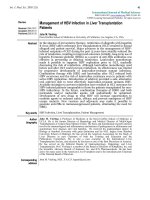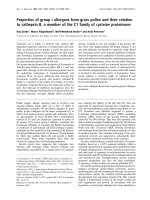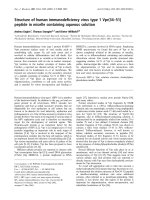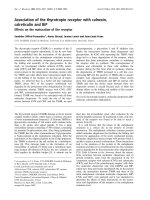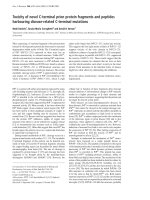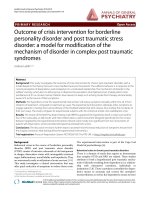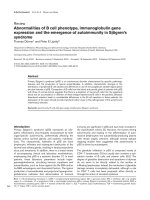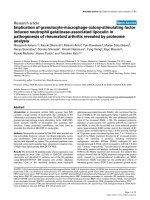Báo cáo y học: "Correlations of HBV Genotypes, Mutations Affecting HBeAg Expression and HBeAg/ anti-HBe Status in HBV Carriers"
Bạn đang xem bản rút gọn của tài liệu. Xem và tải ngay bản đầy đủ của tài liệu tại đây (300.8 KB, 7 trang )
Int. J. Med. Sci. 2006, 3
14
International Journal of Medical Sciences
ISSN 1449-1907 www.medsci.org 2006 3(1):14-20
©2006 Ivyspring International Publisher. All rights reserved
Research paper
Correlations of HBV Genotypes, Mutations Affecting HBeAg Expression and HBeAg/
anti-HBe Status in HBV Carriers
Chee Kent Lim
1 2
, Joanne Tsui Ming Tan
3
, Jason Boo Siang Khoo
4
, Aarthi Ravichandran
5
, Hsin Mei Low
6
, Yin Chyi Chan
1
and So Har Ton
1
1. School of Arts and Sciences, Monash University Malaysia, Petaling Jaya 46150, Malaysia
2. Faculty of Biotechnology, Malaysia University of Science and Technology, Petaling Jaya 47301, Malaysia
3. Discipline of Medicine, Blackburn Building D06, University of Sydney, NSW 2006, Australia
4. Institute of Molecular and Cell Biology, 61 Biopolis Drive (Proteos), 138673, Singapore
5. Department of Biological Sciences, Faculty of Sciences, National University of Singapore, 10 Kent Ridge Crescent, 119260,
Singapore
6. Faculty of Medicine, Nursing and Health Sciences, Monash Immunology and Stem Cell Laboratories, Level 3, STRIP 1 -
Building 75, Monash University, Wellington Road, Clayton, VIC 3800, Australia
Corresponding address: Dr. So Har Ton, E-mail: ; telephone + (603) 56360600 Ext 3526; fax +
(603) 56358640
Received: 2005.09.25; Accepted: 2005.12.15; Published: 2006.01.01
This study was carried out to determine the effects of hepatitis B virus genotypes, core promoter mutations
(A
1762
G
1764
→T
1762
A
1764
) as well as precore stop codon mutations (TGG→TAG) on HBeAg expression and HBeAg/ anti-
HBe status. Study was also performed on the effects of codon 15 variants (C
1858
/ T
1858
) on the predisposition of precore
stop codon mutations (TG
G→TAG). A total of 77 sera samples were analyzed. Fifty one samples were successfully
genotyped of which the predominant genotype was genotype B (29/ 51, 56.9 %), followed by genotype C (16/ 51, 31.4
%). Co-infections by genotypes B and C were observed in four samples (7.8 %). To a lesser degree, genotypes D and E
(2.0 % each) were also observed. For core promoter mutations, the prevalence was 68.8 % (53/ 77) for A
1762
G
1764
wild-
type and 14.3 % (11/ 77) for T
1762
A
1764
mutant while 9.1 % (7/ 77) was co-infected by both strains. The prevalence of
codon 15 variants was found to be 42.9 % (33/ 77) for T
1858
variant and 16.9 % (13/ 77) for C
1858
variant. No TAG
mutation was found. In our study, no associations were found between genotypes (B and C) and core promoter
mutations as well as codon 15 variants. Also no correlation was observed between HBeAg/ anti-HBe status with
genotypes (B and C) and core promoter mutations.
Key words: HBV, Genotypes, HBeAg, Core Promoter Mutation, 1858 Variants, Precore Stop Codon Mutation
1. Introduction
The hepatitis B virus (HBV) is currently categorized
into eight genotypes (A to H). The HBV genotyping
system was first introduced by Okamoto et al. [23] with
four genotypic groups (A to D) distinguished by 8.0 %
threshold divergence between the genomes of HBV.
Subsequently, the genotypes were extended to include
genotypes E, F, G and H [3, 21, 29]. Thus, currently there
are 8 accepted genotypes (A to H) for HBV.
Genotypes have been found to be geographically
distributed. Genotype A is predominant in Northern
Europe and North America. Genotypes B and C are
observed mainly in Asia including China, Japan and
South-east Asian regions. The Mediterranean region has
genotype D as the most prevalent strain. Genotype E is
localized mainly in parts of East, Central and West Africa.
As for genotype F, it is found mainly in South and Central
Americas [21]. So far, genotype G has been found in the
USA and France [29]. Genotype H is found in Central
America [3].
The presence of Hepatitis B e antigen (HBeAg) in the
serum is used as a serological marker that correlates with
the presence of viral replication with liver damage
occurring. As HBeAg disappears from the serum,
antibody to HBeAg (anti-HBe) will become detectable.
The appearance of anti-HBe in the blood stream indicates
biochemical and histological improvement of the liver
injury with decreased viral detection. However, as anti-
HBe becomes prominent, the wild-type viral population
will be replaced by mutants that do not produce or have
decreased HBeAg expression. These mutants may be
advantageously selected for by the anti-viral activity of
the anti-HBe. The fact that HBV genome has a very high
mutation rate which is estimated to be 10
4
fold higher than
the human genome or at an estimated range of 1-10 x 10
-5
per site per year may also support the occurrence of the
mutants [24, 27].
A few mutations in the HBV genome could affect
HBeAg production. The two which are widely studied are
the core promoter dual mutations (A
1762
G
1764
→T
1762
A
1764
)
and precore stop codon mutations (TG
G→TAG). The core
promoter mutations are located within the DNA
regulatory element that binds to nuclear binding protein
[32]. This region is located upstream of the transcriptional
start sites for precore-mRNA and the pregenomic RNA
(pgRNA) [37]. The transcript of 3.5 kb precore-mRNA is
responsible for the translation of HBeAg while the 3.4 kb
pgRNA transcript is used for viral core protein production
and also serves as the template for viral DNA replication.
These dual mutations could decrease the transcription of
the precore-mRNA which is the precursor RNA template
for the production of HBeAg but ironically increases the
viral replicative capability as transcription of the pgRNA
is enhanced [19].
Int. J. Med. Sci. 2006, 3
15
As for the precore stop codon mutation (TGG→TAG)
at codon 28 of the precore/ core gene, it is a mutation that
occurs in the nucleotide position of 1896, substituting
guanine to adenine [4]. It is a nonsense mutation that
converts tryptophan to a stop codon in the precore
segment of the precore/ core gene. This will abort the
translation of HBeAg. As HBeAg does not form part of the
viral particle, it can be dispensed without affecting the
formation of the viral particles.
Although not involved in HBeAg production
directly, codon 15 variants (C
1858
/ T
1858
) are significant as
they are involved in base pair bonding with nucleotide
1896 in the secondary loop structure of the pgRNA [33].
This loop structure functions as an encapsidation signal
which recruits the HBV polymerase for the synthesis of
HBV genome. The occurrence of cytosine at nucleotide
1858 (C
1858
variant) prevents the stable formation of
precore stop codon mutation (TG
G→TAG) due to the
weak binding force with adenine at nucleotide 1896, thus
destabilizing the secondary loop structure. Whereas
thymine at nucleotide 1858 (T
1858
variant) allows flexibility
in that it can stably bonds with adenine at nucleotide 1896
and so resulting in precore stop codon mutation
(TG
G→TAG) but can also wobble pairs with guanine at
nucleotide 1896 in the TG
G wild-type without disrupting
the secondary loop structure [17].
A number of reports have been published on the
correlations between HBV genotypes, core promoter
mutations (A
1762
G
1764
→T
1762
A
1764
), precore stop codon
mutations (TG
G→TAG), codon 15 variants (C
1858
/ T
1858
)
and HBeAg/ anti-HBe status but conflicting results have
been observed. Therefore, it is our interest to examine
these correlations in HBV originated from Malaysian
carriers.
2. Materials and Methods
Samples
A total of 77 sera samples infected with HBV were
used in this study. Samples were collected from the
Tengku Ampuan Rahimah Hospital, Klang, Malaysia,
Sunway Medical Center, Malaysia and Hospital Universiti
Kebangsaan, Malaysia. The HBV carriers were diagnosed
through routine blood screening for hepatitis B surface
antigen (HBsAg) and were tested positive for HBsAg for
more than 6 months of repeated testing. Sera samples
were withdrawn from infected individuals using sterile
syringes and were stored in individual blood collection
tubes to avoid cross-contamination. These were kept at -70
o
C until required. Patients’ consents were obtained prior
to study.
Preparation prior to PCR
Samples were concentrated using Integrated
SpeedVac™
System (ISS-110) (Savant Technologies) at
medium drying rate for 2 hours. Approximately 1.4 mL
serum was concentrated to a final volume of 400 μL. The
concentrated sera were then centrifuged for 10 minutes at
20000 g to separate any lipid or protein found in
suspension. Subsequently, HBV nucleic acids were
extracted from 200 μL of the concentrated sera using High
Pure Viral Nucleic Acid Kit (Roche).
Genotyping using nested PCR with type specific primers
PCR amplifications were performed using PCR
Reagent System (Invitrogen). Two sets of primers
developed by Naito et al. [20] were used. The first set
amplified the region between pre-S and S regions of HBV
genome. The amplified PCR product was then subjected
to another round of PCR using the second set of primers
consisting of 6 pairs of primers. Each primer pair would
yield PCR product with size that corresponds to a
genotype (A to F).
Genotyping using PCR-RFLP on the pre-S region
This method was performed to complement the
genotyping method above in order to obtain an overall
better result on the genotypes of the HBV. Primers
designed by Lindh et al. [14] were used to amplify the pre-
S region of the HBV genome using PCR Reagent System
(Invitrogen). PCR products were digested separately with
AvaII (New England Biolabs) and DpnII (New England
Biolabs) to produce restriction fragment length
polymorphism (RFLP) patterns. These patterns were
compared with patterns of known genotypes (A to F) as
observed by Lindh et al. [14].
Core promoter mutations (A
1762
G
1764
→T
1762
A
1764
)
analysis
The method for this analysis was adapted from
Takahashi et al. [32]. This method was based on the
creation of Sau3AI restriction site on the PCR product if
T
1762
A
1764
dual mutations were present. The PCR product
amplified from A
1762
G
1764
wild-type would not have the
restriction site created. Subsequently, PCR products were
digested with Sau3AI (New England Biolabs) and
observed on 2.0 % agarose gel (Promega). Digested
products for T
1762
A
1764
dual mutations would yield 197 bp
and 110 bp while A
1762
G
1764
wild-type would be
undigested and remained at 307 bp.
Codon 15 variants (C
1858
/ T
1858
) analysis
The method used for this analysis was adapted from
Lindh et al. [16]. Using primers designed by Lindh et al.
[16], EcoNI restriction site would be created when PCR
amplification on T
1858
variant was performed.
Amplification with C
1858
variant as the template would not
produce the restriction site. Subsequently, PCR products
were digested with EcoNI (New England Biolabs) and
observed on 2.0 % agarose gel (Promega). T
1858
variant
would produce 20 bp and 190 bp restriction products
while C
1858
variant would be undigested and remained at
210 bp.
Precore stop codon mutations (TGG→TAG) analysis
The method for this analysis was adapted from
Lindh et al. [13]. This method was based on creation of
Bsu36I restriction site on the PCR product if precore stop
codon mutation (TA
G) was present. The PCR product
amplified from wild-type without the precore mutation
(TG
G) would not have the restriction site. Subsequently,
PCR products were digested with Bsu36I (New England
Biolabs) and observed on 2.0 % agarose gel (Promega).
Digested DNA products for precore stop codon mutants
(TA
G) would yield 34 bp and 160 bp while DNA from
precore wild-type (TG
G) would be undigested and remain
at 194 bp.
HBeAg/ anti-HBe status determination
The determinations of the HBeAg and anti-HBe
status were performed on unconcentrated sera using
AxSYM® HBe 2.0 (Abbott) and AxSYM® anti-HBe
(Abbott) immunoassay kits in the Abbott AxSYM®
System (Abbott) automated blood analyzer.
Int. J. Med. Sci. 2006, 3
16
Quantifications for relative titer levels of both HBeAg and
anti-HBe were performed based on the mean rate of the
Index Calibrator provided and calculated as the cutoff
rate, CO. The calculation was based on the ratio of the
sample signal rate to cutoff rate for each of sample and
control (S/CO). A sample was considered to be HBeAg
positive when its S/CO ratio was ≥ 1.0 and anti-HBe
positive when its S/CO ratio was < 1.0. In the case for
anti-HBe, a smaller S/CO ratio registered indicated a
higher level of the antibody. To better reflect the anti-HBe
relative titers, unit for anti-HBe was reported as CO/ S in
this paper.
Statistical analysis
Chi-square tests were performed between the
genotypes, core promoter mutations, codon 15 variants,
precore stop codon mutations and HBeAg/ anti-HBe
status. Kruskal-Wallis non-parametric ranked sum test
was used to analyze the correlation between the
genotypes and core promoter mutations with the relative
mean HBeAg titer levels. A P value of less than or equal to
0.050 was considered to be significant.
3. Results
HBV genotypes observed using nested PCR with type
specific primers
Using this method, 37.7 % (29/ 77) of the samples
were found to be infected by HBV genotype B, 19.5 % (15/
77) by genotype C, 1.3 % (1/ 77) by genotype D, 1.3 % (1/
77) by genotype E and 3.9 % (3/ 77) by co-infections of
genotypes B and C whereas 36.4 % (28/ 77) did not yield
any PCR products (Table 1).
HBV genotypes observed using PCR-RFLP on the pre-S
region
Using this method, 13.0 % (10/ 77) of the samples
were found to be infected by HBV genotype B, 6.5 % (5/
77) by genotype C, 1.3 % (1/ 77) by co-infections of
genotypes B and C (Table 1). Nine sera (11.7 %) yielded
low HBV-DNA PCR products where genotypes could not
be determined while three sera (3.9 %) produced unique
RFLP patterns that did not correspond to any RFLP
patterns with known genotypes as observed by Lindh et
al. [14]. 63.6 % (49/ 77) of the samples did not yield any
HBV-DNA PCR products.
Table 1: The genotypes determined by the two different
methods
Genotypes Determined by the different methods used Metho
ds
used
B C D E B and C
co-
infectio
ns
Low
PCR
product
s*
Untypabl
e+
PCR
negati
ve
Tot
al
Naito
et al.
(2001)
29
(37.7
%)
15
(19.5
%)
1
(1.3
%)
1
(1.3
%)
3
(3.9%)
− − 28
(36.4%
)
77
Lindh
et al.
(1998)
10
(13.0
%)
5
(6.5%
)
− − 1
(1.3%)
9
(11.7%)
3
(3.9%)
49
(63.6%
)
77
* PCR product yield low thus genotype could not be determined accurately.
+ Genotype untypable due to unique RFLP pattern produced that did not
correspond to any known genotyped RFLP pattern as observed by Lindh et al.
[14].
Overall genotypes observed using the two genotyping
methods above
Combining the results from both genotyping
methods, the prevalence were 56.9 % (29/ 51) for
genotype B, 341.4 % (16/ 51) for genotype C, 2.0 % (1/ 51)
each for genotypes D and E respectively (Table 2). Four of
the sera (7.8 %) were co-infected by genotypes B and C.
Table 2: Combination of genotyping results determined using
methods developed by Lindh et al. [14] and Naito et al. [20]
Genotypes
B C D E B and C*
Total
Number of samples 29
(56.9%)
16
(31.4%)
1
(2.0%)
1
(2.0%)
4
(7.8%)
51
* Genotypes B and C co-infections. This included a sample that was determined
to be genotype C when using method developed by Naito et al. [20] but was
determined to be co-infected by genotypes B and C when method developed by
Lindh et al. [14] was used.
Core promoter mutations (A
1762
G
1764
→T
1762
A
1764
)
Of the 77 sera analyzed, it was observed that 53 sera
(68.8 %) were infected by A
1762
G
1764
wild-type virus while
11 (14.3 %) by T
1762
A
1764
mutants. Seven (9.1 %) of the sera
were found to be co-infected by both A
1762
G
1764
wild-type
and T
1762
A
1764
mutant. Six sera did not yield any PCR
product. Statistical analysis between the genotypes B and
C with A
1762
G
1764
wild-type, T
1762
A
1764
mutants and co-
infections by A
1762
G
1764
wild-type and T
1762
A
1764
mutants
gave a P value of 0.054 which was very closed to being
significant (Table 3).
Table 3: Distribution of genotypes B and C with core promoter
mutations and codon 15 variants
Core promoter mutations Codon 15
variants
Genotypes
A
1762
G
1764
wild-
type
T
1762
A
1764
mutant
Co-
infections
T
1858
C
1858
B 20
(71.4 %)
2
(7.1 %)
6
(21.4 %)
16
(84.2
%)
3
(15.8
%)
C 12
(75.0 %)
4
(25.0 %)
− 8
(72.7
%)
3
(27.3
%)
Note: samples that were co-infected by genotypes B and C were not included.
Codon 15 variants (C
1858
/ T
1858
)
Of the 77 sera, 46 of them yielded PCR products and
were analyzed for the codon 15 variants. The prevalence
of codon 15 variants was found to be 42.9 % (33/ 77) for
T
1858
variant and 16.9 % (13/ 77) for C
1858
variant. No
correlation was found between genotypes B and C with
C
1858
/ T
1858
variants (P= 0.45) (Table 3).
Precore stop codon mutations (TGG→TAG)
71 (92.2 %) of the sera yielded PCR products with all
being TG
G wild-type. The rest did not yield any PCR
products.
HBeAg/ anti-HBe status
It was observed that 42.9 % (33/ 77) of the sera were
HBeAg positive while 54.5 % (42/ 77) of the sera were
anti-HBe positive. Two sera (2.6 %) were found to be
positive for both HBeAg and anti-HBe. Chi-square test
between genotypes B and C with HBeAg/ anti-HBe status
revealed no significant difference (P= 0.34) (Table 4). This
was also true for core promoter mutations (A
1762
G
1764
wild-type, T
1762
A
1764
mutants and co-infections) with the
HBeAg/ anti-HBe status (P= 0.77) (Table 5).
Int. J. Med. Sci. 2006, 3
17
Table 4: Distribution of genotypes B and C with HBe/ anti-HBe
status
Genotypes HBe Anti-HBe
B 15
(51.7 %)
14
(48.3 %)
C 10
(66.7 %)
5
(33.3 %)
Note: samples that were co-infected with genotypes B and C were not included.
This also applied to samples with positivity for both HBe and anti-HBe.
Table 5: Distribution of core promoter mutations with HBe/
anti-HBe status
HBe Anti-HBe Core promoter mutations
n S/ CO* n
A
1762
G
1764
wild-type 23
(43.4 %)
217.0 ± 123.7 30
(56.6 %)
T
1762
A
1764
mutant 5
(45.5 %)
108.1 ± 100.2 6
(54.5 %)
Co-infections 4
(57.1 %)
187.7 ± 124.7 3
(42.9 %)
* Reported as mean ± standard deviation.
HBeAg/ anti-HBe relative titer levels
The relative mean titer for HBeAg was 195.9 S/ CO
with standard deviation of 123.5. Categorically, for core
promoter mutations status, A
1762
G
1764
wild-type, T
1762
A
1764
mutants and co-infections had relative mean titer levels of
217.0 ± 123.7 S/ CO, 108.1 ± 100.2 S/ CO and 184.7 ± 124.7
S/ CO respectively (Table 5). However, a Kruskal-Wallis
test between the HBeAg relative titer levels of the core
promoter mutations status did not reveal any significant
difference (P= 0.27). No comparison could be made for
precore stop codon mutations as no TA
G was detected in
this study. The relative mean titer observed for anti-HBe
was 12.7 CO/ S with standard deviation of 14.7 CO/ S.
The high standard deviation seen was due to a single
outlier with very high relative titer of 100.0 CO/ S when
compared with others.
4. Discussion
From the comparisons of the observations of HBV
genotypes using the two above methods, it could be
deduced that the genotyping method using nested PCR
with type specific primers was more sensitive than PCR-
RFLP on the pre-S region. There was overall consistency
between the genotypes observed using nested PCR with
type specific primers with PCR-RFLP on the pre-S region.
No different genotype was observed for any one
particular sample except for the cases involving co-
infections by genotypes B and C. The genotypes B and C
co-infection observed using PCR-RFLP on the pre-S region
was found to be infected only by genotype C when nested
PCR with type specific primers was used. Comparison
could not be made for the genotypes B and C co-infections
observed using nested PCR with type specific primers as
no PCR product was obtained for these particular samples
when PCR-RFLP on the pre-S region was used. We
attempted to verify two of the three co-infections
produced by the nested PCR technique through cloning
and sequencing but we only managed to obtain singular
genotypic infections for every each of them (data not
shown). The single co-infection sample produced by the
PCR-RFLP technique was checked using cloning and
restriction analysis with AvaII and DpnII. However, we
only managed to verify for the presence of genotype C
infection in all the clones screened (data not shown). The
reason for these observations could be attributed to the
small clone numbers we had used for sequencing and the
single genotypes observed might be the predominant
species. The three un-typed RFLP patterns observed using
PCR-RFLP on the pre-S region were determined to be of
one genotype B and two genotypes C respectively when
the nested PCR with type specific primers was used.
These were verified through sequencing of the PCR
products produced by the PCR-RFLP technique (data not
shown). The low PCR product yields obtained using the
PCR-RFLP on the pre-S region could be due to the nature
of the technique used where amplification was performed
only once. This was in contrast to the nested PCR
technique where two rounds of amplifications were
performed. In the subsequent statistical tests, co-infections
by genotypes B and C as well as genotypes D and E were
excluded from analyses.
Our observation for the prevalence of genotypes was
in concordance with those results reported by a few
studies [11, 14, 23]. The studies showed that genotypes B
and C were more common in the Asia-Pacific regions with
genotype B being more predominant. We had indeed
observed that genotypes B and C were the main strains
infecting HBV carriers in Malaysia with the former being
more predominant. However region-wise, this result was
different from that reported by Sugauchi et al. [30] who
reported that genotype C was more predominant in the
Thai population. In Japan, genotype C was more
predominant than genotype B [24]. All these observations
followed the trend that genotypes B and C were localized
in the Asia-Pacific regions but with varying degree of
predominance. Given the same geographic endemicity of
genotypes B and C, co-infections by these two genotypes
are not surprising. Few other studies had also reported
genotypic co-infections [10, 35]. This shows that co-
infections could be quite common indeed.
Many studies had shown that the core promoter
mutations (A
1762
G
1764
→T
1762
A
1764
) were more common in
genotype C than in genotype B [9, 15, 25, 28]. The present
study did not detect significant difference. Nevertheless, it
is interesting to note that the statistical test produced a
result which was very close to being significant (P= 0.054).
Possibly, a significant result could be obtained given a
bigger sample size. In some other studies, correlation
between genotypes and core promoter mutations was not
observed [7, 11]. The conflicting results observed could
imply that there might be other factors that are involved
in determining the correlation.
Sugauchi et al. [31] had proposed that within
genotype B, two genotype B subtypes exist namely Bj
which is found mainly in Japan and Ba which is found in
some other Asian countries such as China, Hong Kong,
Taiwan, Thailand and Vietnam. The Ba strain has
recombination with genotype C in the precore region and
the core gene whereas Bj strain is without any
recombination [31]. They observed that Ba strain had
higher prevalence of the core promoter mutations than in
Bj strain (33 % vs. 15 %). This fact might be relevant to our
case as the subtypes might influence the observation we
had. The observation by Sugauchi et al. [31] has made the
subtypes Ba and Bj as another variable to look at in the
correlation analysis between genotypes and core promoter
mutations. The varying proportions of the Ba and Bj
subtypes within genotype B samples might influence the
correlation outcome of the core promoter mutations with
Int. J. Med. Sci. 2006, 3
18
genotype B. As we do not know the proportions of Ba and
Bj subtypes in our genotype B samples, thus the core
promoter mutations we observed might be influenced by
the varying degree of proportions of Ba and Bj subtypes.
Besides that, the co-infections of both A
1762
G
1764
wild-type
and T
1762
A
1764
mutants in our genotype B samples could be
attributed by co-infections of Ba and Bj subtypes, where
one subtype contributed the A
1762
G
1764
wild-type and the
other subtype contributed the core promoter mutation. It
is interesting to note that only genotype B samples had co-
infections of both A
1762
G
1764
wild-type and T
1762
A
1764
mutants but this phenomenon was not observed for
genotype C samples.
Several studies revealed that core promoter
mutations might be influenced by the existence of precore
stop codon mutations where an inverse relationship
between core promoter mutations and precore stop codon
mutations was seen [5, 6]. However, we observed
otherwise, where low numbers of core promoter
mutations were observed and no precore stop codon
mutations were observed. Thus, it could be that core
promoter mutations might also be influenced by factors
such as geography or ethnicity, hence the prevalence of
core promoter mutations were not based on genotypes
alone. Although Malaysia has a multi-ethnic population
(mainly inhabited by the Malays, Chinese and Indians in
respective order of proportions), we were not able to
perform the relationships with the ethnics due to
incomplete data of the ethnic origins of our samples.
Associations between codon 15 variants (C
1858
/ T
1858
)
and genotypes had been mentioned. The C
1858
variant was
closely associated with genotypes A, F and H as well as
genotype C but not with genotypes B, D and E [2, 3, 12]. In
our case, although 15.8 % (3/ 19) of the genotype B with
positive results for codon 15 analysis was C
1858
variant,
significant difference was not observed (P= 0.45).
Nevertheless, we still observed a higher prevalence of
C
1858
variants in genotype C samples than in genotype B
(27.3 % vs. 15.8%).
In this study, analysis on codon 28 at the precore
region revealed that all the sera were infected by TG
G
wild-type. A few studies had observed certain correlations
between genotypes and precore stop codon mutations
(TG
G→ TAG) [6, 7, 15]. Within the same geographic
region, Huy et al. [9] reported that genotype B was linked
to TA
G mutation. However, conflicting results on the
correlation between genotypes and precore stop codon
mutations (TG
G→ TAG) had been reported elsewhere.
Orito et al. [25] observed no significant difference between
the predispositions to TA
G mutation development
between genotypes B and C. Besides that, Kidd-Ljunggren
et al. [11] did not observe any such correlation in samples
of various geographic origins. As no TA
G mutation was
observed in our case, this study was in contrast to that of
Huy et al. [9] where in our case, TA
G mutation was
predisposed by genotype B even though large number of
genotype B samples was observed (n= 28). The failure to
observe any TA
G mutation in our case might be
significant by itself. This is because various other studies
reported at least some precore stop codon mutations in
their study [6, 7, 9, 11, 15, 25]. Thus, it could be possible
that TA
G mutations are influenced by other factors as well
such as geography, ages and ethnics. Besides that,
genotype B subtypes might play a role here. Although no
significant difference was observed, Sugauchi et al. [31]
reported that TA
G mutations were more frequent in Bj
than Ba subtype (50% vs. 18 %). Therefore, there is a
possibility that there is a higher prevalence of Ba subtype
in our samples which leads to the absence of any TA
G
mutants. However, many other Asian countries such as
China, Thailand and Vietnam where high prevalence of
Ba was reported, still observed the occurrences of TA
G
mutants [31].
Based on the secondary stem loop structure of the
pgRNA, theoretically, there should be correlation between
nucleotide at 1858 in codon 15 with nucleotide at 1896 in
precore region at codon 28 of the precore/ core gene [33].
No correlation analysis could be made in our study as no
TA
G mutation was observed. Nevertheless, our result
fitted the general concept in that no TA
G mutation should
occur together with C
1858
variant as we did not observe the
co-existence of C
1858
variants with TAG mutations.
No significant correlation was observed between
HBeAg/ anti-HBe status with genotypes B and C. This is
in contrast to several studies which reported that patients
infected by HBV genotype B were more prone to be
HBeAg negativity than those infected by genotype C [15,
28]. On a regional basis, this study was also in contrast to
that reported by Sugauchi et al. [30] where in a Thai
population, they observed that HBeAg positivity were
more prevalent in sera infected by genotype C than by
genotype B. Some studies had shown that patients
infected by genotype C experienced longer period of
being in HBeAg positivity with delayed seroconversion to
anti-HBe status [15, 24]. This might explain the reason
why correlation was not observed in this study. If the
above statement held true, the proportion of HBeAg/
anti-HBe could depend on the timing of sample collection
as well. This could complicate the matter in hands as one
would seldom know when infection was initiated.
The emergence of anti-HBe immunity puts selective
pressure against the HBV that express HBeAg.
Hepatocytes harbouring the wild-type HBV would be
eliminated due to the display of HBeAg on the cell
membrane which would be targeted by the immune
response. Thus mutants that lack or have decreased
HBeAg expression would evade the immune response
and survive [26]. The observation of co-infections by both
A
1762
G
1764
wild-type and T
1762
A
1764
mutants could indicate
an ongoing selection process, which given time, could see
the total exclusion of the wild-type. Regrettably, we were
not able to follow up on the cases studied for a longer
period of time. As the HBV were under selective pressure,
they might evolve fully into mutants sometime in the
future.
Statistical significant difference was not observed for
HBeAg/ anti-HBe status with core promoter mutations
(A
1762
G
1764
→T
1762
A
1764
). This was in contrast to some
observations reported where core promoter mutations
(A
1762
G
1764
→T
1762
A
1764
) were linked to HBeAg
seroconversion to anti-HBe [8, 22]. In concordance to this
study, a few reports did not find any correlation between
the core promoter mutations with HBeAg/ anti-HBe
status [7, 15, 25, 32]. We observed a substantial number of
T
1762
A
1764
mutants infecting sera with HBeAg positivity.
This phenomenon could be explained by the fact that the
occurrence of T
1762
A
1764
mutation only decreased the
production of HBeAg, not totally abolishing it. Therefore,
the presence of T
1762
A
1764
mutants does not necessarily
mean the absence of HBeAg detection. Many other reports

